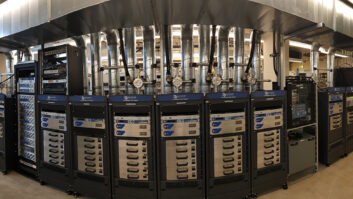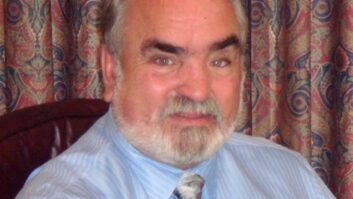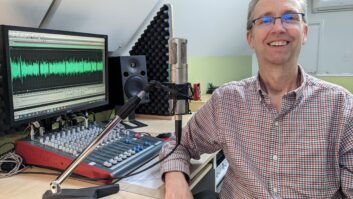Chuck Bullett is the market engineering manager for the Cumulus cluster in San Francisco. Chuck has a station event/remote broadcast to produce every spring that has always presented a problem. This year, old technology brought a solution.
The broadcast position for the event is more than 1,300 feet from the sound stage at an outdoor festival. KFOG(FM) produces the festival every year as a gift to the city of San Francisco.

Fig. 1: Kill the hum using old WE111C repeat coils. The problem is that they need to send the FOH (Front of House) position an analog feed from their broadcast position for the culminating event: an extensive fireworks display syncopated to a special music montage that station production specialist Jeff Schmidt scores against a MIDI track beforehand.
A sidebar story is that the MIDI track, which is scored on an eight-channel ADAT tape against the music montage, is then fed as an AFSK feed over a coordinated RPU frequency via an old Marti transmitter to a compatible receiver. The receiver is an old Motorola HT200 handheld on the pyrotechnics launch barge, located safely offshore out in San Francisco Bay.
The number of public agencies involved in the event numbers over 20 and includes the U.S. Coast Guard, San Francisco P.D., California Highway Patrol, Fire Department, numerous production companies for the bands, the San Francisco 49ers facility staff, and many, many, more. You now get the idea. This is a big event!
Because the FOH and broadcast stage are so far apart, it is nearly impossible to get the two locations equalized to the same ground potential. This results in tremendous artifacts in the audio feed over a multi-pair snake. The artifacts usually manifest themselves as a nasty buzz. To complicate things further, the two production positions are not on the same generator.

Fig. 2: The coils mount neatly to a rack panel. Initially, Chuck considered using a digital snake to conquer this problem, either purchasing or renting one. In the end, it really wasn’t in the budget, so Chuck and his engineering team got creative.
He headed to his AM transmitter site and gave the problem a good old chin scratch while looking at a shelves of spare parts that have been gathered on site over 80 years of broadcast operations.
What caught Chuck’s eye were a number of old Western Electric 111C coils that had been removed from service well over 20 years ago.
The transformers’ technical specifications are tremendous considering what they really are (iron and copper), and how old they are. The old and trusty 111C coil provides for an honest and balanced 600/600 ohm connection that is guaranteed to block any hum or noise source.
Engineers familiar with the 111C coil will recall that depending on how they’re jumpered, a 600/150 ohm, 600/600 ohm or 150/150 ohm match is available. Plus, they’ll ring out to well past 15 kHz. Bill Whitlock’s “Handbook for Sound Engineers, 3rd Edition” extols the virtues of the Western Electric 111C Telephone Repeat Coil, and provides plenty of design data for anyone wishing to experiment in more modern applications.
But rest assured, the venerable 111C coil will exceed your expectations and preserve your maintenance and repair budget. You won’t have to invest in any of the numerous hum and buzz eliminators that are available on the market.
Cumulus San Francisco Transmitter Supervisor and Chief Engineer John Buckham quickly soldered up appropriate XLR termination pigtails for each transformer, as seen in Fig. 1. Meantime, Chuck drilled out an old rack panel and mounted each repeat coil on it as shown in Fig. 2.

Fig. 3: Mounted in an Anvil case and ready to knock out some buzz! The panel was mounted in an old, forgotten Anvil road case to give the assembly the mechanical and electrical stability required for its mission, an intensive season of broadcasts from music festivals throughout the Bay Area. Fig. 3 shows the finished product mounted in the case.
The result? About two hours of some shop time yielded five channels of extremely robust hum and buzz elimination, and at least $300 or $400 saved in the maintenance budget.
Chuck encourages readers to Google the Western Electric 111C coil. You’ll be amazed at the information you’ll find.
* * *
Tom Norman is a senior engineer with Burst Video; he writes relative a recent Workbenchcomment by Paul Sagi regarding grounding conductors.
He says everything written was correct, but notes that parallel conductors have lower bulk resistance and lower bulk inductance than single conductors.
Tom has used this principle to good effect in providing isolated grounding systems for rows of equipment racks, for example. Not every lesson learned in RF has applications restricted to RF!
Two runs of #10 round wire would have greater surface area and less inductance than a single run of #10 square conductor, for example, and it would be available locally, and virtually anywhere.
John Bisset marked his 40th year in radio in broadcasting recently. He is international sales manager for Europe and Southern Africa for Nautel and a past recipient of the SBE’s Educator of the Year Award. Reach him at[email protected]. Faxed submissions can be sent to (603) 472-4944.
Submissions for this column are encouraged and qualify for SBE recertification credit.












